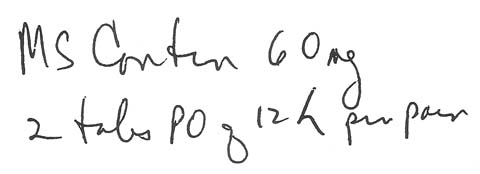
| Contents | Previous | Next |
A doctor ordered the sustained-release form of "morphine, MS Contin, 60 mg q12h." Because the pharmacy usually dispensed this drug in 30 mg tablets, the nurse transcribed the order in the medication administration record (MAR) like this:
|
|
Without notifying the nurses, the pharmacy dispensed 60 mg tablets, which had recently become available. So the nurses gave two of the 60 mg tablets with each dose. A discrepancy in the narcotics inventory sheet alerted them to the error.
With better communication between the two departments, this error never would have occurred. It also could have been prevented if the nurse had transcribed the order more clearly. You should use three separate lines in the MAR to transcribe orders when other than a single tablet or capsule is needed for a dose. Here's what to do.
On the first line, write the drug name and total dose ordered. The number of tablets or capsules, along with the strength of each, goes in parentheses on the second line. If you aren't sure about the strength, call the pharmacy. On the third line, complete the order by recording the administration route, frequency, and other information. Here's how the order for MS Contin should have been written:
|
|
Remember, the first line should always include the dose for single-ingredient drugs, not the number of tablets or capsules. For example, "K-Dur, 2 tablets" is unclear, because it comes in 10 mEq and 20 mEq tablets. Even if only one strength is available,
you should include it when transcribing the order. Chances are, another strength will be marketed sooner or later. Your pharmacists should also follow this recommendation when labeling unit doses and when building a computerized drug inventory.
The nurse who transcribed this order did one thing right: She indicated that the nurses should give two tablets. When more than one tablet or capsule is needed per dose, someone is likely to forget and give only one. That's a good reason for pharmacists to dispense medications in the exact dose whenever possible. Also, they could consider formulating a capsule or supplying a liquid form when a patient must take a large number of tablets for one dose. Besides being more conevenient for the patient, it cuts down on the potential for making errors, because the nurse and patient have fewer tablets to handle.